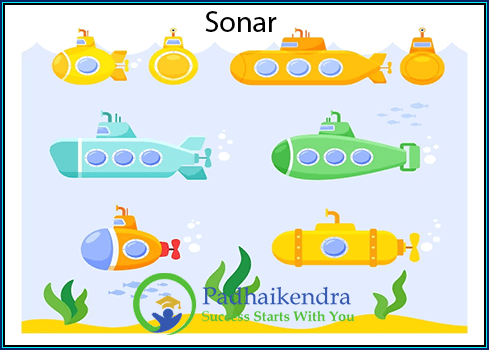Sonar, short for Sound Navigation and Ranging, is a technology that utilizes sound waves to navigate, locate objects, and gather information about the underwater environment. Widely used in marine and underwater applications, sonar plays a crucial role in various fields, including navigation, defense, fisheries, and scientific research. This article delves into the workings of sonar and explores its diverse applications.
Working of SONAR
 Sonar operates on the principle of sound wave propagation and reflection. It involves the transmission of sound waves into water or other mediums and the detection of returning echoes. The process can be broken down into the following steps:
Sonar operates on the principle of sound wave propagation and reflection. It involves the transmission of sound waves into water or other mediums and the detection of returning echoes. The process can be broken down into the following steps:
Transmitter: A sonar system begins with a transmitter that emits sound waves, typically in the form of short pulses of high-frequency sound.
Sound Wave Propagation: These sound waves travel through the water at a speed determined by the properties of the medium. The waves propagate in all directions and encounter objects or boundaries in their path.
Reflection: When the sound waves encounter an object or boundary, they bounce back or reflect off it. The reflected waves carry information about the object’s distance, shape, and composition.
Receiver: The sonar system includes a receiver that captures the returning echoes. The receiver converts the received sound signals into electrical signals for processing and analysis.
Data Processing: The electrical signals are processed to extract relevant information, such as the distance to the object, its size, and its movement. Sophisticated algorithms and signal-processing techniques are employed to enhance the accuracy and clarity of the collected data.
Applications of Sonar
Sonar technology finds numerous applications across various industries and scientific fields. Here are some key uses of sonar:
Navigation and Mapping: Sonar systems are vital for underwater navigation, enabling ships, submarines, and underwater vehicles to determine their position, avoid obstacles, and create detailed maps of the seafloor.
Fisheries: Sonar is extensively used in commercial fishing to locate fish shoals, determine their size and density, and assess fish populations. This information helps fishermen optimize their catch and practice sustainable fishing.
Defense and Security: Sonar plays a crucial role in naval operations, allowing submarines to detect and track other vessels, underwater mines, and potential threats. It is also used in harbor security to monitor underwater activities and identify suspicious objects.
Oceanography and Environmental Research: Sonar aids scientists in studying the ocean and underwater ecosystems. It helps measure water depth, map underwater topography, identify marine species, and monitor the impact of human activities on marine environments.
Search and Rescue: Sonar systems are utilized in search and rescue operations to locate objects or individuals submerged in water. They help locate shipwrecks, aircraft debris, and missing persons, enabling faster and more efficient recovery efforts.
Oil and Gas Exploration: Sonar is employed in offshore oil and gas exploration to survey the seafloor, identify potential drilling locations, and map subsea infrastructure.
Archaeology: Sonar assists in underwater archaeological surveys, helping to locate and map submerged historical sites, shipwrecks, and artifacts.
Sonar technology revolutionizes our understanding of the underwater world, providing valuable insights into its vast depths. From enabling safe navigation to facilitating scientific exploration and resource management, sonar plays a pivotal role in diverse applications. As technology advances, sonar systems continue to evolve, offering improved accuracy, resolution, and capabilities. With ongoing research and innovation, sonar will undoubtedly continue to push the boundaries of our knowledge and exploration of the underwater realm.
Sonar FAQs
- Signal attenuation: Sound waves can lose energy and become weaker as they travel through water, limiting the range and accuracy of sonar systems.
- Interference: Background noise and echoes from multiple sources can interfere with the detection and interpretation of sonar signals.
- Resolution: The ability to resolve small details or objects close together may be limited depending on the frequency and design of the sonar system.
- Environmental factors: Water conditions, such as temperature, salinity, and turbulence, can affect the propagation of sound waves and introduce uncertainties in sonar measurements.
- Navigation and mapping of the underwater topography, such as ocean floors and lake bottoms.
- Detection and tracking of underwater objects, such as submarines, ships, and underwater structures.
- Fish finding and fisheries research, helping to locate schools of fish and determine their depth.
- Underwater exploration and scientific research, including studying marine life and geological features.
- Search and rescue operations, assisting in locating and recovering objects or individuals lost at sea.
- Active sonar: This type of sonar emits sound waves and listens for the echoes.
- Passive sonar: This type of sonar listens for sounds generated by other sources, such as marine animals or machinery.
- Side-scan sonar: It provides detailed images of the seafloor by scanning a wide area using sound waves.
- Multibeam sonar: It uses multiple beams of sound to create a more detailed and accurate image of the underwater environment.
- Doppler sonar: It measures the change in frequency of sound waves reflected off moving objects to determine their speed and direction.
- Ability to navigate and gather information in environments where visual observations are limited or impossible, such as underwater or in murky conditions.
- Long-range capabilities, allowing for detection and measurement of objects over large distances.
- Real-time data acquisition, enabling rapid decision-making and response in various applications.
- Non-intrusive nature, as sonar systems do not require physical contact with the objects being detected or measured.





